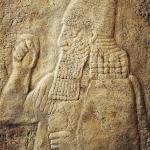American biblical archaeologist Bryant G. Wood (b. 1936) obtained an M.A. in Biblical History from the University of Michigan in 1974 and a Ph.D in Syro-Palestinian archaeology from the University of Toronto in 1985. He argues for a 15th century B.C. date of the Exodus, and is the author of The Palestinian Evidence for a Thirteenth Century Conquest: An Archaeological Appraisal (1987) and The Sociology of Pottery in Ancient Palestine: The Ceramic Industry and the Diffusion of Ceramic Style in the Bronze and Iron Ages (JSOT Press for the American Schools of Oriental Research, 1990), and is a contributor to the Biblical Archaeology Review, the Israel Exploration Journal and the Near East Archaeological Society Bulletin.
American biblical archaeologist James K. Hoffmeier (b. 1951) is Professor Emeritus of Old Testament and Ancient Near Eastern History and Archaeology at Trinity Evangelical Divinity School. His M.A. from the University of Toronto in 1975 was in Egyptian Archaeology in 1975, and his PhD from the same university focused on Egyptian Religion in 1977. He is the author of Israel in Egypt: The Evidence for the Authenticity of the Exodus Tradition (Oxford University Press, 1996), and Ancient Israel in Sinai: The Evidence for the Authenticity of the Wilderness Tradition (Oxford University Press, 2005). He contends for a 13th century B.C. date of the Exodus
They wrote “competing” articles about the date of the Exodus in the prestigious Journal of the Evangelical Theological Society: Wood’s “The Rise and Fall of the 13th-Century Exodus-Conquest Theory” in September 2005 (1) and Hoffmeier’s “What is the Biblical Date for the Exodus? A Response to Bryant Wood” in June 2007 (2). I’d like to hone in on one particular sub-topic in this debate: internal biblical chronology in relation to the date of the Exodus. Wood states,
The internal chronological data in the Hebrew Bible clearly support a mid-15th century BC date for the exodus. The primary datum is 1 Kgs 6:1 which states, “In the four hundred and eightieth year after the Israelites had come out of Egypt, in the fourth year of Solomon’s reign over Israel, in the month of Ziv, the second month, he began to build the temple of the Lord.” Working back from Solomon’s fourth year, ca. 966 BC, brings us to ca. 1446 BC for the date of the exodus. (3)
Shishak, Sheshonk I of Egyptian records, is mentioned in 1 Kgs 14:25, providing an important synchronism with Rehoboam’s 5th year. The dates of Sheshonk’s reign are 945–924 BC. This synchronism falls on the year 925 BC , thus producing the date for the end of Solomon’s reign, ca. 930 BC. Because Solomon is allotted 40 years (1 Kgs 11:42), his 4th year should be ca. 966/7 BC. (4)
I reject Wood’s view that there is a single authoritative “biblical” chronology. . . . 1 Kings 6:1 . . . only records the time period from Solomon’s 4th regnal year to the departure from Egypt, viz. 480 years. The Septuagint reads 440 rather than 480, a difference of 40 years. Neither of these figures, however, agrees with the period derived from tallying the years in retrograde order from 1 Kings 6 back to the Book of Exodus. Here are the data provided by the OT:*3 years – Solomon’s 4th year (1 Kgs 6:1)40 years – the length of David’s reign (1 Kgs 2:10)40 years – the length of Saul’s reign (1 Sam 13:1)30 years – estimated length of Samuel’s leadership40 years – length of Eli’s judgeship (1 Sam 4:18)20 years – length of Samson’s judgeship (Judg 15:20)40 years – length of Philistine oppression (Judg 13:1)8 years – length of Abdon’s judgeship (Judg 12:14)10 years – length of Elon’s judgeship (Judg 12:11)7 years – length of Ibzan’s judgeship (Judg 12:9)6 years – length of Jephthah’s judgeship (Judg 12:7)18 years – length of Ammonite oppression (Judg 10:8)22 years – length of Jair’s judgeship (Judg 10:3)23 years – length of Tola’s judgeship (Judg 10:2)3 years – length of Abimelech’s rulership (Judg 9:22)40 years – period of Gideon’s deliverance and peace (Judg 8:22)7 years – length of Midian’s oppression (Judg 6:1)40 years – period of peace after Deborah and Barak’s victory (Judg 5:31)20 years – length of Jabin’s oppression (Judg 4:3)3 years – length of Shamgar’s judgeship (Judg 3:31)80 years – period of Ehud’s deliverance and peace (Judg 3:30)18 years – length of Moabite oppression (Judg 3:14)40 years – period of peace after Othniel’s victory (Judg 3:11)8 years – length of Mesopotamian oppression (Judg 3:8)20 years – period from end of conquest to death of Joshua and the elders (Judg 2:6–7)7 years – period of Joshua’s conquest until the tribal allotments40 years – length of time in the wilderness (Num 14:33)*633 years – total number
Where the Bible does not specify the number of years, I have taken the minimal number. Just three years for Shamgar’s judgeship is assigned, which corresponds to the shortest period assigned to a ruler (i.e. Abimelech who was killed in battle), and the length of Samuel’s judgeship easily could be longer than the 32 years proposed here. Paul’s 40 years could have been used (Acts 13:21). . . . Then, too, the period from the end of the conquest until the death of Joshua could be longer than the 20 years I allocated above. Consequently, 633–650 years could be the time span for the period from Solomon’s 4th year to the exodus from Egypt according to this biblical chronology. Thus it could be argued that there are several biblical chronologies based on the OT. One places the exodus 633–650 years before Solomon’s 4th year, and the other occurs 480 years before work commenced on the temple. Then, too, there is the shorter LXX -based chronology. So, which chronological system represents “biblical chronology”? (5)
I am unaware of any historian who follows this dating because it pushes the date of the exodus, sojourn, and patriarchs too far back for anyone’s reckoning. This ultra-early chronology, nonetheless, is every bit as “biblical” as the one yielding the 1446/47 BC date. (6)
It has long been thought that the 480-year figure of 1 Kgs 6:1 might be a symbolic figure that derives from 12 times 40—40 years being a symbolic number for a generation—thus signifying that 12 generations had elapsed between the exodus and Solomon’s 4th year. Since men were usually married and had children by age 20–25, a period closer to 300 years would be more accurate. When one adds 300 to 967 BC, an Exodus date around 1267 BC (20 years into the reign of Ramesses II) results. (9)
There is no basis for such an interpretation, biblical or otherwise. Nowhere in the Bible is it hinted that a “full” or ideal generation was 40 years in length. Quite the contrary, in the Hebrew Bible 40 years is often stipulated as a standard period of elapsed time. (10)
Moreover, there were more than 12 generations between the exodus and Solomon. In 1 Chr 6:33–37, 18 generations are listed from Korah, who opposed Moses (Numbers 16; cf. Exod 6:16–21), to Heman, a Temple musician in the time of David (1 Chr 6:31; 15:16–17). Adding one generation to extend the genealogy to Solomon results in 19 generations from the exodus to Solomon, not 12. Using [an] estimated length of a generation of ca. 25 years yields a total estimated time span of 475 years, a figure that compares well with the 480 years of 1 Kgs 6:1. (11)
The number 40 is one of the most frequently used numbers in the OT, and when used to signify a block of years, it occurs 33 times in the OT. This use is only surpassed by a block of seven years, which occurs 34 times. (14)
The use of definite numerical expressions in an indefinite sense, that is, as round numbers, which is met with in many languages, seems to have been very prevalent in Western Asia from early times to the present day. . . . the modern Turks have 4 typical numbers which are often used in proper names with little or no reference to their exact numerical force–3, 7, 40, 1,001. . . . The modern Persians use 40 in just the same way. “Forty years” with them often means “many years” . . . This lax use of numbers, as we think, was probably very frequent among the Israelites and their neighbors. . . . It is probably often used in that way in the Bible where it is remarkably frequent, . . . all [the many examples] suggest conventional use, or the influence of that use, for it can hardly be supposed that the number in each of these cases, and in others which might be mentioned, was exactly 40. How it came to be so used is not quite certain, but it may have originated, partly at any rate, in the idea that 40 years constituted a generation or the period at the end of which a man attains maturity, an idea common, it would seem, to the Greeks, the Israelites, and the Arabs. The period of 40 years in the wilderness in the course of which the old Israel died out and a new Israel took its place was a generation (Nu 32:13, etc.). (15)
***
Practical Matters: Perhaps some of my 4,200+ free online articles (the most comprehensive “one-stop” Catholic apologetics site) or fifty-one books have helped you (by God’s grace) to decide to become Catholic or to return to the Church, or better understand some doctrines and why we believe them.
Or you may believe my work is worthy to support for the purpose of apologetics and evangelism in general. If so, please seriously consider a much-needed financial contribution. I’m always in need of more funds: especially monthly support. “The laborer is worthy of his wages” (1 Tim 5:18, NKJV). 1 December 2021 was my 20th anniversary as a full-time Catholic apologist, and February 2022 marked the 25th anniversary of my blog.
PayPal donations are the easiest: just send to my email address: [email protected]. You’ll see the term “Catholic Used Book Service”, which is my old side-business. To learn about the different methods of contributing, including 100% tax deduction, etc., see my page: About Catholic Apologist Dave Armstrong / Donation Information. Thanks a million from the bottom of my heart!
***
Photo credit: The Israelites Leaving Egypt, c. 1828, by David Roberts (1796-1864) [public domain / Wikimedia Commons]
***
Summary: I survey an honest disagreement between Christian archaeologists Hoffmeier & Wood as to the date of the Exodus, based on how one interprets biblical chronologies.














